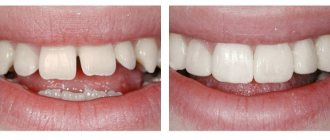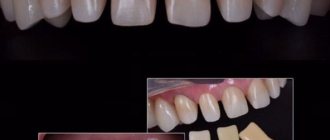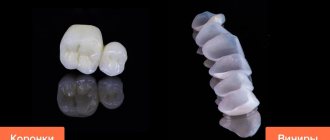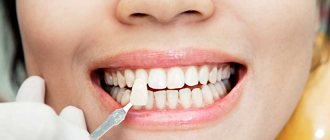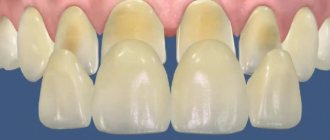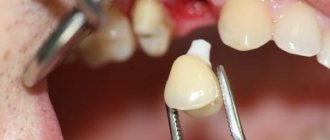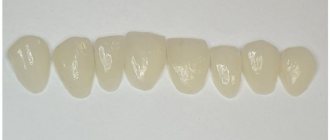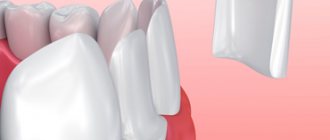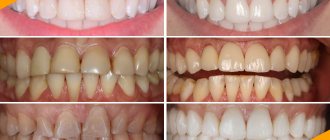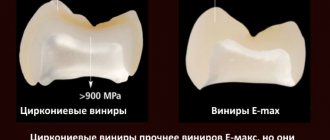Content
- Indications
- When installation is not performed
- Which veneers to choose
- Composite veneers
- Porcelain veneers
- Zirconium veneers
- Veneer installation sequence
- Installation of composite veneers
- Restoration with ceramic veneers
- Rules for using veneers
A person does not always have a naturally perfect smile. The cause may be enamel defects and uneven tooth shape. Modern technologies make it possible to solve this problem. One of the most popular methods is the installation of veneers, plates glued to the teeth. With their help, the dentition looks perfectly straight.
Veneers hide imperfections in teeth and provide a beautiful smile.
Advantages of ceramic mini-prostheses
Restoring teeth with veneers allows you to get a perfect smile in just 2 visits to the dentist.
On the first visit, which lasts no longer than 30-40 minutes, an examination, preparation, and formation of an impression for the manufacture of prostheses are carried out. After 5-7 days, a second session is scheduled to install veneers. Getting used to mini-prostheses occurs in just a couple of days. Important! In some cases, teeth grinding is required to install veneers.
The procedure is painless, and the layer of enamel that will be removed is minimal (no more than 1 mm). Caring for veneers is simple - the same rules as for general oral hygiene. Only toothpaste should be chosen without abrasives or with a minimum content of them.
Indications for tooth restoration with veneers
Decorative plates are designed to provide an aesthetic appearance to the front teeth. Chewing teeth are rarely decorated, since the linings are not suitable for high chewing loads. In addition, this is an expensive procedure. To wear veneers, use 8-10 lower and upper units or less.
Indications for aesthetic tooth restoration with veneer:
- Yellowed enamel;
- Change in color due to depulpation;
- Stains on enamel;
- Destruction of enamel;
- Incorrect position of teeth in a row;
- Irregular shape of teeth;
- Changing colors of fillings over time;
- Mechanical defects.
PROMOTION
Ceramic veneers
RUB 11,500
Types of veneers and methods of their installation
Based on the restoration method, direct and indirect veneers can be distinguished. Direct correction is carried out during one session. For restoration, a special light-polymer material is used. Indirect veneers are installed in several stages.
Depending on the material used to make the linings, there are composite and ceramic linings. Each of these types has its own advantages and disadvantages.
Composite
The installation process of such overlays is extremely simple. Initially, the doctor assesses the condition of the patient’s teeth and selects the color of the filling material. The Vita scale is used for this. The next stage is partial grinding of the teeth. From 0.3 to 0.5 mm of enamel is removed. Composite material is applied to the prepared teeth and polished.
The disadvantage of such veneers is their tendency to stain. Because of this, the patient needs to stop drinking colored liquids, coffee and tea in the future. The composite material is quite soft, so the pads can wear down and become rough. To keep veneers in good condition, periodic adjustments are necessary. With proper care and timely visits to the doctor, composite onlays can last up to 7 years.
Ceramic
To make such veneers, metal-free ceramics are used. They are characterized by high strength and durability. Ceramic products, unlike composite ones, are made in the laboratory by a dental technician.
Ceramic dental restoration involves the following stages:
- Grinding the tooth surface.
- Taking an impression.
- Making ceramic structures in the laboratory.
- Fitting and fitting of the finished product.
- Fixing the onlay on the dental plate using a special material.
Ceramics are practically no different in color and transparency from teeth. Products made from it do not stain, do not fade and have a long service life. Ceramic structures will last from 7 to 15 years. There is no discomfort after veneering.
Other types
There are also zirconium veneers. This material has high biological compatibility with human tissue. The cost of such products is much higher than the price of ceramics or composites.
Overlays made from leucide glass-ceramic materials have good aesthetic properties. Their peculiarity is that there is no need to grind down tooth enamel.
Lumineers are otherwise called Hollywood veneers. These are very thin plates made from high quality porcelain. Their thickness does not exceed 0.3 mm. The process of installing lumineers takes a minimum of time, and there is no need for tooth preparation. Their maximum service life is 15 years. If necessary, such overlays can be easily removed.
Photos before and after installation of lumineers
When veneers are not installed
The technique has contraindications:
- High risk of injury to the jaw - for example, when getting into boxing;
- Bad habits;
- Bruxism;
- High washability;
- Large filling;
- Bite pathology.
If the tooth is rapidly decaying, a crown should be preferred. It is advisable to install several veneers at once.
All veneers are divided into two types:
- Therapeutic - they are installed on the teeth using a direct method, the need for their use is not so much aesthetic as protective - they protect teeth from destruction;
- Orthopedic - they are made in a laboratory, glued to the tooth, do not eliminate pathology, aesthetics are a priority.
When it is impossible to restore teeth with veneers
The dentist makes a decision on the advisability of installing ceramic plates based on the condition of the teeth and the oral cavity as a whole. The patient’s lifestyle and habits are also taken into account.
In some cases, resorting to veneering is not recommended:
- Most of the tooth is occupied by a filling, and preparation for installing a veneer is impossible due to the risk of cracks.
- A thin layer of enamel can also cause refusal to install a mini-prosthesis if additional preparation is required.
- Uncorrected bite defects – direct and reverse.
- Passion for sports associated with facial injuries or frequent falls (boxing, wrestling).
- The habit of chewing hard objects, for example, onychophagia - the habit of biting nails.
- Involuntary grinding of teeth during sleep (bruxism).
- The absence of several chewing teeth.
- Teeth are prone to increased wear.
Important! In mild cases of bruxism, installation of veneers is possible provided that the patient uses a protective silicone mouthguard while sleeping.
A professional dentist always considers and analyzes all options. If restoring teeth with veneers is not possible, the doctor will suggest other methods of restoring the dentition. You can learn more about all the methods on the website https://stom-info.ru.
Calculator: calculate prices online
Calculation of the cost of turnkey veneers
Calculate the cost of installing veneers yourself.
For an accurate final calculation, the cost of fixation is added to each veneer - 500 rubles. and once for the entire work, the cost of casts is 1200 rubles.
Choose the type of veneers
0
Please indicate the required number of veneers
Better and more accurate - in a free consultation! All addresses and telephone numbers are on the website chudostom.ru. Make an appointment by calling the branch closest to you.
The calculation is not a public offer; the final cost is determined at a free consultation BEFORE the start and does not change during the treatment process.
Total cost rub.
0
Porcelain veneers
Manufacturing material – ceramics. Can be used to eliminate interdental gaps, darkened enamel, and irregularly shaped teeth. Well suited for restoration of anterior teeth.
The advantage is a translucent structure that provides high aesthetic qualities similar to natural enamel.
Flaws:
- The tooth needs to be ground down.
- Higher cost of restoration with veneers compared to composite.
Service life – 15 years.
What’s better: getting veneers or restoring teeth?
Both procedures make the smile more aesthetically pleasing and correct visual defects. Despite this, they have fundamental differences. It is impossible to say unequivocally what is better - to install veneers or carry out restoration. It is necessary to consider each clinical case separately and make a decision after discussing the problem with the dentist.
Restoration
Dental restoration is the process of restoring the integrity of an incisor or canine. It is necessary in the presence of chips and cracks; it refers to cosmetic manipulations, since the main task is to obtain a beautiful smile line.
Advantages:
- performed in one visit;
- takes from 15 minutes to one hour for one tooth;
- has an affordable cost because it is performed using filling material;
- the patient does not experience any discomfort during the procedure;
- allows you to completely restore the aesthetics of your smile and hide visual defects - gaps, cracks, chips.
Flaws:
- the material is quite fragile and can chip again if handled carelessly;
- filling material is susceptible to food coloring;
- After a while you have to replace it.
On a note!
Artistic restoration is an effective, quick and affordable method to correct visual imperfections in the smile line.
Veneers
Veneers are also classified as restoration, but are considered an indirect method. This method involves installing ceramic or other material onlays on a tooth with a defect. This allows you to restore its aesthetics.
Advantages:
- long service life;
- the ability to obtain the desired appearance of the smile line;
- Absolute masking of chips and cracks in teeth.
Flaws:
- lengthy production of plates, which does not allow the procedure to be completed in one visit to the dentist;
- high price;
- the need to observe special rules of caution;
- the need for preliminary tooth preparation.
On a note!
Veneers are an effective and durable method of restoring the aesthetics of the dentition.
Comparison
Often patients do not see the difference between restoration and veneering. If you compare these methods for restoring the smile line, you can find a number of differences:
- Preparation time. Veneers are made within a few days, after which they are installed on the enamel. The restoration is performed directly in the patient's mouth during the first appointment.
- Price. A ceramic onlay for one incisor costs from 5 – 7 thousand rubles. The price of artistic restoration starts from 1 – 2 thousand.
- Operational life. The records last on average 5-10 years. Filling cement lasts on enamel from 1 to 5 years.
- Care. Veneers require some precautions. The restored part can also break off, so you will have to follow special care rules.
- Contraindications. The list of restrictions for veneering is longer than for artistic restoration of integrity.
- Side effects. Plates require preliminary grinding of the enamel, but restoration does not. Therefore, side effects in the form of increased sensitivity after veneering appear more often.
Important!
The indications for installing ceramic onlays and parts made of composite material are the same. Therefore, the patient can choose any method of restoring the smile line, but it is better to first consult with the dentist.
Choosing the best veneers
Most doctors prefer to use ceramic onlays. Such devices can completely match the natural color and texture of living teeth. Ceramic veneers are produced in special laboratory conditions. They have high precision, which helps to adhere to the tooth surface as much as possible. Composite overlays do not have these properties.
Orthopedic pads are reliable. In addition, they reduce the risk of the appearance and development of caries. Bacterial infection often occurs in the space between the tooth and the artificial material. Therefore, the lesion may cause an ineffective restoration. Basically it all depends on the skill of the doctor. Before installing any device, the tooth must be thoroughly cleaned.
It is difficult to choose the best veneers . The doctor determines which pads to install, taking into account the individual case of each patient. To correct the aesthetic problem of one tooth, composites and ceramics are suitable.
Indirect restoration
This restoration method has a number of advantages compared to the one described above.
Stages of implementation
Restoration of lost tissue or elimination of defects on the front surface of a tooth is often performed in a dental laboratory using ceramics or zirconium dioxide.
The whole process takes place in several stages:
- A shade that matches the natural color of the teeth is selected, as well as the shape is agreed upon with the patient.
- The tooth is turned to the thickness of the plate. It can reach 1-1.5 mm, which depends on the material used for the product, as well as the condition of the hard tissues of the tooth and the individual characteristics of the enamel. If the preparation is accompanied by discomfort and unpleasant pain, then local anesthesia is given to relieve increased sensitivity.
- After grinding, an impression is taken using a special silicone or alginate elastomer, which, when hardened, retains a negative reflection of the tooth surface.
- Temporary plastic veneers are attached to the ground teeth, which protect the tooth from exposure to food in the mouth and other external damage.
- In a dental laboratory, a plaster model is cast from the impression, on which the future veneer is modeled and the wax is replaced with material. After firing, the ceramics are painted in the required shade and covered with glaze.
- The finished structure is tried on in the oral cavity and fixed with special cement.
Advantages
Ceramic veneers are widely used as structures for microprosthetics for defects of the vestibular surface of teeth and have a wide range of advantages:
- Veneers do not change color while being worn, since porcelain does not absorb pigments from food and drinks.
- Due to the high degree of transparency, ceramic plates give restored teeth a natural shade; during an external examination, it can be difficult to determine which is a natural tooth and which is a veneer.
- For ceramics and zircon, minimal enamel preparation is required, and for lumineers, no more than 0.3 mm of dental tissue is removed.
- Long period of operation of the microprosthesis. With proper care and gentle treatment, the linings can last up to 15 years.
- Since there is no metal frame, aesthetic indicators are significantly higher than when replacing lost tissue with metal-ceramic crowns.
Flaws
The disadvantages of the indirect veneering method include its higher cost. Moreover, the price can vary significantly depending on the type of material and the thickness of the plate.
In case of weakened dental tissues, a veneer will only create the appearance of a beautiful smile, but will not make the teeth stronger, therefore, if the destruction index is high, it is recommended to restore lost enamel and dentin with the help of crowns.
Ceramic veneers are quite fragile, so it is necessary to ensure that the teeth covered with plates do not come into contact with solid food (nuts, seeds or candies). Possible injuries and impacts should be avoided, as even a slight blow to the neck of a bottle or cup can lead to cracks in the product.
To decide on the method of teeth veneering, you need to weigh all the advantages and disadvantages of each type of product and consult with a specialist who will advise what is best to choose.
Author: Violeta Kudryavtseva, dentist, especially for Karies.pro
Types of tabs
Depending on the nature and extent of tooth damage, one of three types of inlays can be used.
- Inlays. They have the shape of a rectangle and are inserted inside the dental crown without affecting the tubercles of the chewing surface. Exactly repeat the shape of the tooth.
- Onley. They are distinguished by a T-shape. Completely close the cavity and cover the chewing surface.
- Veneers. Almost transparent onlays made of thin porcelain or ceramics, which are made based on dental impressions in the laboratory. Used for restoration of anterior teeth. Made in accordance with the natural color of the enamel.
Veneer care
Once installed, composite or other veneers require careful care. You cannot bite hard food, limit traumatic effects and the influence of external factors. It is forbidden to bite foreign objects.
The patient must take good care of his teeth. Use toothbrushes, floss and irrigators. In addition, veneers need polishing. This procedure is performed by a dentist. Once every six months you need to undergo a doctor’s examination and, if necessary, make corrections to the composite veneer. With proper care, the service life of the linings will be long.
Methods and timing of restoration
The method and timing of restoration of a damaged prosthesis depends on the amount of work to be done. There are basic methods for restoring ceramic crowns, which are used in different cases.
Polishing - used for minor cracks in places inaccessible to view. A special substance with polishing properties and a brush are used. During the polishing process, the shape of the artificial tooth may change. Therefore, the method is used only for processing invisible spaces. The process lasts no more than 30 minutes and takes place in one session.
Replacing a prosthesis is the most expensive and reliable method. The damaged crown is removed by drilling or removal after exposure to a softener. In the laboratory, a new structure is made according to the parameters of the old one, then the doctor fixes the crown in the oral cavity. This recovery method will take about two weeks.
Removal and restoration - this method shows the least effectiveness, since it is almost impossible to remove the crown intact. The damaged surface is treated with a special solution using an ultrasonic device. The process may take 2-5 days.
In situ restoration is the filling of a damaged artificial tooth directly in the mouth. Using modern composites, a specialist recreates the original appearance of the surface. This procedure is carried out in one go. The main disadvantage is that there is no guarantee that the effect of ceramic crown restoration will last long enough.
Manufacturing and installation of composite veneers
To manufacture and install veneers from composite materials, one visit to the dentist is enough. Initially, the doctor will perform hygienic cleaning of the oral cavity at a professional level, which is necessary for ideal cleanliness of the surface of the teeth.
After this, the color is selected using a special scale, which is necessary for an exact match of the color of the tooth and the composite. After this, the surface of the tooth is prepared to create a better bond between the tooth and the composite. Then the stage of applying the adhesive and forming the veneer coating is performed, followed by grinding and polishing the created surface.
